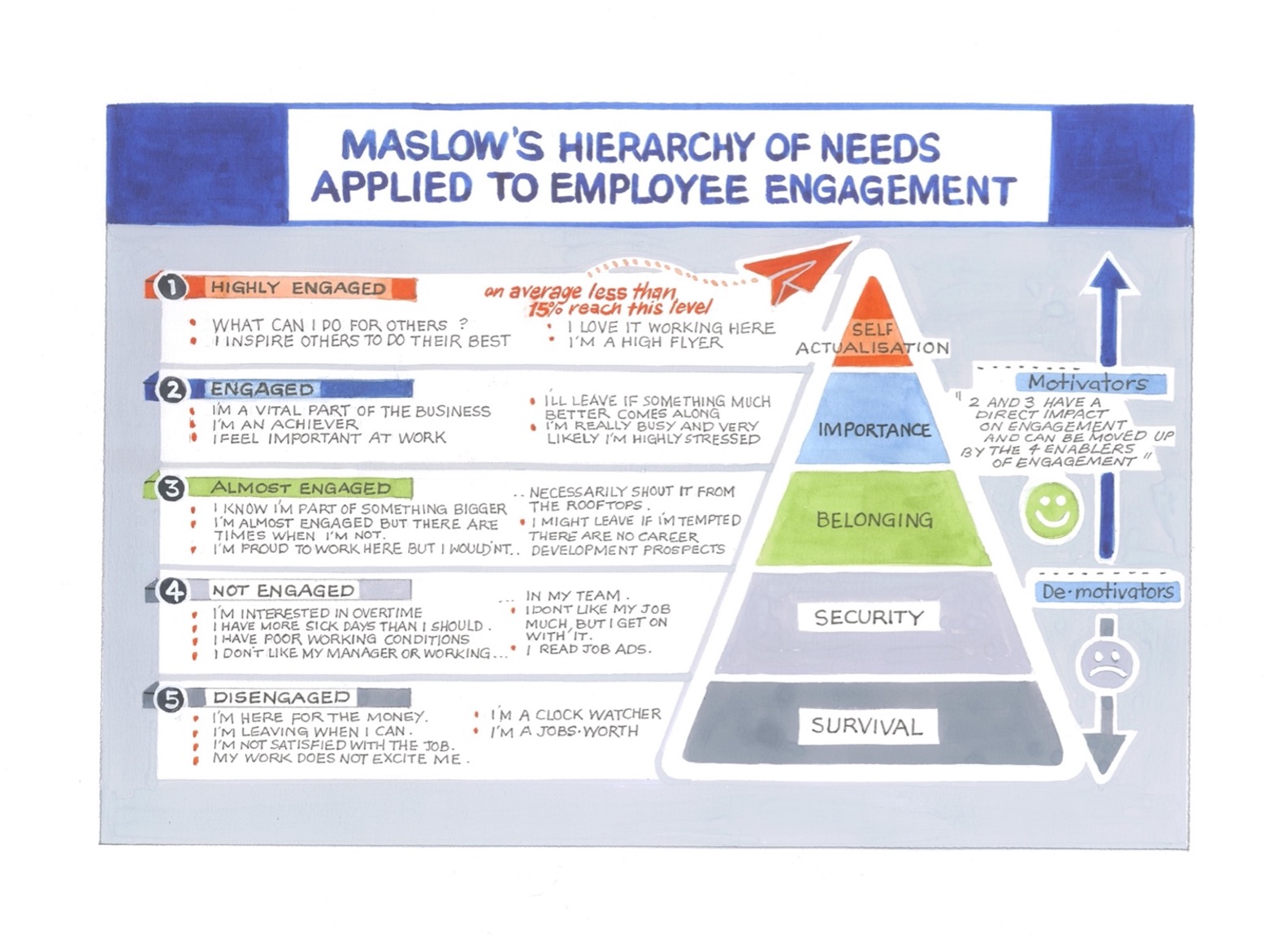
What do I use Maslow's Hierarchy of Needs to measure?
Where are you & your team on the triangle?
Maslow’s Hierarchy of Needs is often used to determine an employee’s level of satisfaction with their role. It’s a great visual tool, too, and it can be used to establish where people are in relation to their current mood. For any team to work, the foundations have to be in place before it can become highly engaged.
I use Maslow’s tool to gauge where people are on a daily basis, so I have an idea of what they are thinking and feeling as well as how they are behaving.
Maslow’s Hierarchy of Needs is available as a free download.
As you can see from the diagram below, the base of the triangle is SURVIVAL. It is followed by SECURITY, then BELONGING, IMPORTANCE, and finally, at the top of the triangle is SELF ACTUALISATION.
Below is a description of what each step signifies and its impact on individuals, organisations, and even whole countries.
Look at the triangle and imagine what would you would be seeing, hearing and feeling at each step on it.

Survival
I’m only here for the money.
I’m leaving as soon as I can.
I’m not satisfied with the job I do.
My work doesn’t excite me.
I’m a clock-watcher.
I’m a jobs-worth.
It’s fair to say that in this part of the triangle, employees would be disengaged, look unhappy and have little energy. In other words, they would just be plodding through the day. You identify them easily by just looking at their faces and listening to what they say. Having people in your team who are just there for the money and intend on leaving the business as soon as possible can be soul-destroying for others. The behaviour of unhappy people can be destructive, so it is important that you do not ignore it simply because a conversation could lead you to saying, “I’ll help you find a role in another company that excites you.” Sometimes, the right thing for all concerned is to have that conversation and help those team members move on, even if that means leaving the team and the organisation.
Security
I’m interested in overtime.
I have more sick days than I should.
I have poor working conditions.
I don’t like my manager or working in my team.
I don’t like my job much, but I get on with it.
I read job ads.
It’s fair to say that employees in this section of the triangle are not engaged, and they still have sad faces because they are de-motivated. You need to tell them what you see to raise their awareness that their behaviour is obvious and has an impact on those around them. This is like giving them a mirror and saying, “Have a look yourself, what do you see looking back at you?” You could get their absence records and show them what it looks like on paper, especially if you have identified any patterns, like the fact that they frequently take Mondays and Fridays off sick. Here, you would question the employee to seek to understand what is going on in their lives that is affecting their behaviour. Doing this will undoubtedly be challenging, but if this was your business, would you want to continue paying a salary to someone who was off work a lot or who didn’t seem to want to be there? The likelihood is they are motivated by security, so they stay in their job even though they don’t like it. They are too comfortable, and they need moving out of their comfort zone and into their learning zone where they will grow
Belonging
I know I’m part of something bigger.
I like it here some days, other days I don’t. Some days it’s fun, other days it’s boring.
I’m proud to work here, but I wouldn’t necessarily shout it from the roof tops.
I might leave if I’m tempted.
There are no career development programmes here.
At this point, you will be starting to see, sense and hear evidence of engagement. When people get to the middle of the triangle, they are almost engaged. Talk to them on a daily basis to question them, listen to them, build rapport with them and set goals with them that would move them forwards. This is a really important stage, and if they are not supported at this point, they can quickly move backwards again. As the team leader, it is part of your role to keep your team moving forward. Apart from anything else, when you do this, it increases engagement because your team will know that you are interested in them and that you want them as part of your team. In other words, they will feel they belong and that they are important, which is the next level on the hierarchy.
Importance
I’m a vital part of the business.
I feel important at work.
I’m really busy, but I also feel I’m stretched and able to grow.
I’m an achiever.
I’ll only leave if something much better comes along.
It’s fair to say that when your team is here, you will see smiles on their faces and sense a high level of energy, enthusiasm and motivation. Here, employees are engaged in the business and would score positively on employee engagement tests. Remember that employees can move up and down the levels of the triangle quickly, so throughout the whole process, you need to work with your team to ensure they stay engaged. It’s easy to forget about people when they reach the level where they feel important because you know that they are performing. As a leader, the majority of your time is probably going to be spent with the under performers because they are the ones that cause you a problem. However, by spending time with those on your team who feel important means, you will be delivering results across all key performance indicators. As a leader, this will give you a lot of positive energy and increased motivation while also helping you to develop your skills and support your own growth.
Self-actualisation
What can I do for others?
I inspire others to do their best.
I love working here!
I’m a high flyer
Only a small minority of any team – on average less than 15 per cent – will reach this level of engagement. These employees are recognised as the high flyers in a business. How many do you know in your organisation? What is it that they do on a daily basis that allows them to be the best?
Once your team has reached the Belonging and Importance level, they are either almost engaged or actually engaged in the business.
If you have good employee engagement results, it means that the majority of your team is in the top three sections of the hierarchy